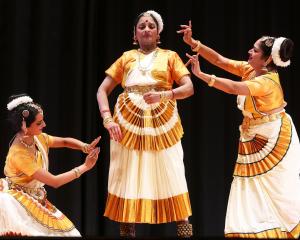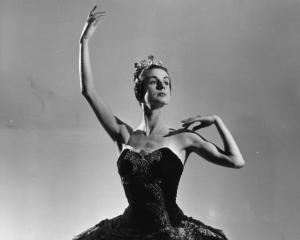
A new star is born in the Royal New Zealand Ballet’s latest new contemporary production The Firebird, choreographed by Laughlan Prior. Rebecca Fox asks what it takes to transform yourself into a bird.
As the firebird, Ana Gallardo Lobaina, head bunts Arrow, the audience breaks into laughter.
The animalistic movement is totally recognisable as the young firebird makes friends with the kind-hearted young scavenger danced by Harrison James in the opening night of the Royal New Zealand Ballet’s (RNZB) season of The Firebird with Paquita.
It is the result of weeks of rehearsals for Gallardo Lobaina as she sought to embody the character choreographer Laughlan Prior has created for her — that of a fertility goddess and guardian of the natural world.
Each day of the six weeks of rehearsals felt like 16 hours as she worked to learn the movements of the new production and develop the character of the firebird.
‘‘I was in so much physical pain for the first three weeks, like so sore, because it’s a different kind of posture trying to portray the arms and back.’’
Yet all that work faded into the background as she hit the stage for opening night unusually calm and relaxed. It was quite unlike her, as she usually feels the nerves and pressure to do well.
She put it down to the work, to knowing the steps so well she could concentrate on making her character come alive — the biggest challenge of the role.
‘‘I think making it look like a bird. Yes you have feathers and a beautiful dress and wings, that helps the visual part of it, but the more you do it, you have to keep adding the layers of the animal side because otherwise she just becomes a human talking to another human.’’
That was very important for Gallardo Lobaina when she portrays the Firebird dying.
‘‘We can all relate to that human side, but she still has to look like a bird, she is a wild animal. You do dying in many roles, but you’re not a dying bird.’’
Those wild animal characteristics are what she hopes to continue to portray each time she performs it.
‘‘I don’t want to fall into a pattern per se. What I’ve been doing so far changes every time I do it. The danger is it could get repetitive and fall into the same pattern so the hardest part is to keep that side fresh.
‘‘I need to find a way to build the story in fresh way every time so they believe I am a bird in all these different stages.’’

Prior describes Gallardo Lobaina’s performance as ‘‘just stunning’’.
‘‘She’s a creature. The way she has taken on the role and really just amplified the animalistic qualities. I don’t see her as human as she takes on properties of the fantastical beast.’’
The day after opening night Gallardo Lobaina could not wipe the smile off her face, despite the lethargy of a ‘‘ballet hangover’’, well aware of making the most of the career-defining moment.
‘‘It is a role that marks a career in a strong way. There will be before Firebird and after Firebird.’’
She remembers the first rehearsal as if it was yesterday — the excitement of having a full-length work made on her for the first time and the trepidation of the unknown.
‘‘It feels like it went by so fast.’’
Then all of a sudden the opening performance was over. There was the applause, lining up with her colleagues to take a bow, receiving flowers and pulling Prior out to join them.
‘‘I’ve never bowed as a principal by myself, this is literally the biggest thing I’ve ever done. The clapping, stomping, was outstanding. I was smiling but felt like I was about to cry.’’
There was an overwhelming sense of reward from feeling she had done what she set out to — to give the audience the best time they could possibly have so when they left the theatre they were on a high.
‘‘We can all relate to the story in general. We’re all going through climate change, we all have known someone in pain — there so many things relate to.’’
The experience has been topped off by an usher, still emotional from seeing the dress rehearsal, asking her for a selfie.
‘‘I thought this is like a superstar moment, this doesn’t happen to me.’’
Gallardo Lobaina does not want to pretend it is not a big deal for her.
‘‘Sometimes [a dancer] never get to do a role like this. Last night was a dream.’’

She knows that better that better than anyone. Having grown up in Cuba, Gallardo Lobaina has worked extremely hard to get where she is.
A dancer from a young age, she moved to Havana aged 14 to study ballet at the Cuban National Ballet School.
A scholarship to the Miami City Ballet School had her family move to the United States when she was 17. She also studied at the Boston Ballet School.
After failing to get in to their associated companies, she auditioned and secured a spot at the Cincinnati Ballet.
When she decided it was time to move on, she began auditioning around Europe and the United States.
‘‘I auditioned for 10 to 15 companies, we’re talking Munich, Dresden, Vienna, New York, Arizona — all over the map. It took a lot of time, money and energy. A lot of denial, a lot of nos.’’
A choreographer she had worked with then recommended auditioning for the West Australian Ballet which she did and in 2017 joined the Perth-based company.
‘‘It’s insane, I would never have thought going to Australia. My mum almost had a heart attack.’’
But she was learning being at the right place, at the right time, with the right connections could change everything.
‘‘Nothing happens just because of talent, you have to be ready for things to happen to you. My life such a living proof of that.’’
However, after two and a-half years, Gallardo Lobaina was struggling, she was unhappy and had problems with eating.
‘‘I wasn’t that secure anymore. I lost self-confidence, worried about my image which affected my dancing. I decided I needed to go. I moved so far from home to do what I loved but I wasn’t at my happiest. So something here is not right, there is no point to keep struggling.’’
So she auditioned for the RNZB securing a place and moving to New Zealand in early 2020.
‘‘New Zealand is closer to home than Perth — that’s how I sold it to my mum.’’
She arrived with a shin stress fracture but found the company welcoming and willing to do what was needed to get her back to full strength.
A quick tour with Tutus on Tour followed her arrival and then lockdown happened.
‘‘Lockdown bought time to heel my bone. Twenty-twenty was one of best years of my life, even though we had Covid destroying everything.’’
Another of the reasons for that was getting one of her dream roles as the Lilac fairy in Sleeping Beauty at the end of last year and then being promoted to soloist.
‘‘So many beautiful things happened. All my body problems disappeared because all of a sudden I’m happy, healthy and working in a nice environment.
‘‘Things line up, things are meant to happen, I’ve been working hard same way I have always worked hard. It’s why I feel so blessed, so lucky this happening to me right now.
‘‘Everything just kind of worked out. Its really exciting, you work really hard whole life for something like this to happen.
‘‘I’m literally on top of the world right now.’’
The only downside is that her family are so far away and her mother is dealing with health issues.
‘‘But you have to focus on work and not let bad news affect you. Do the best you can do and enjoy what I’m doing. They worked really hard for me to be where I’m at today’’
Prior also has a smile on his face. Seeing his vision come to life on stage in front of an opening night audience was enthralling — once he got over opening-night jitters.
‘‘I was beside myself with nerves but I was really proud of everybody.’’
It was even more special as he attended dance school and flatted with James, who is the RNZB’s guest artist from Canada, and the second Firebird, Katherine Skelton, who will be dancing in Dunedin alongside Joshua Guillemot-Rodgerson as Arrow.
‘‘To have us all together after a decade or so is pretty cool.’’
Prior had been asked by the RNZB to produce a new work of The Firebird. It was first staged in Paris in 1910, changing the direction of ballet and catapulting Igor Stravinsky to stardom.
For Prior, Stravinsky’s score perfectly fitted the tale he wanted to tell of a world threatened by climate change.
‘‘We’ve gone past the threshold, the point of no return. The beginning was always going to be an inferno so we crafted the story from there.’’
So by combining his choreography with the costume and set designs of Tracy Grant Lord, lighting by Jon Buswell and animation and visual effects by POW Studios, he was able to create a supernatural world hit by devastating heat and floods where humanity is struggling to survive without water and food.
‘‘It is what I’m most proud of, how it all came together. It definitely makes for a powerful and cathartic show with themes that are relevant to today.’’
Prior’s concerns for the environment become stronger as he gets older and as he thinks of the future for his sister’s children.
‘‘One can feel quite helpless in the giant scale of things. This is my way of making sense of the situation and expressing those concerns in the art form I work in.’’
The Firebird is not without hope though. ‘‘There is a lot of optimism. It looks on the bright side of hope and redemption, that there is a chance to make a change.’’
RNZB Artistic Director Patricia Barker, who stages Paquita before The Firebird, says the very different works complement each other.
‘‘We needed a work that wouldn’t draw away or exhaust people’s compassion so they could be ready to take the journey of The Firebird.’’
Paquita showcases the dancers’ classical technique. ‘‘You can enjoy the tutus, the sparkles of the crystal chandeliers, the clean and clear classic ballet.’’
To see:
Christchurch: Isaac Theatre Royal. Thursday 26, Friday 27 and Saturday, August 28.










